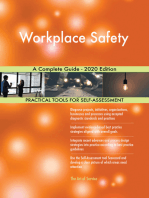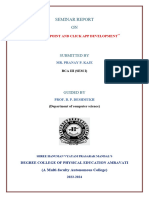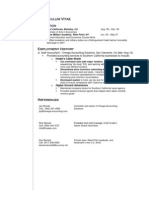CGS Weekly Safety & Health Inspection Report
CGS Weekly Safety & Health Inspection Report
Uploaded by
တိုး ေဝ ေအာင္Copyright:
Available Formats
CGS Weekly Safety & Health Inspection Report
CGS Weekly Safety & Health Inspection Report
Uploaded by
တိုး ေဝ ေအာင္Original Description:
Copyright
Available Formats
Share this document
Did you find this document useful?
Is this content inappropriate?
Copyright:
Available Formats
CGS Weekly Safety & Health Inspection Report
CGS Weekly Safety & Health Inspection Report
Uploaded by
တိုး ေဝ ေအာင္Copyright:
Available Formats
CG Schmidt, Inc.
WEEKLY SAFETY AND HEALTH INSPECTION REPORT
Project Superintendent: Project Name: Job # Date:
1. Paperwork Requirements 8. Tools, Hand and Power 14. Motor Vehicles, Skid Loaders, Forklifts, Backhoes
Copies of OSHA construction standards Inspection and maintenance Regular inspection and maintenance
Emergency telephone numbers Damaged tools repaired/replaced promptly Qualified operators
Maintenance records for equipment Proper grounding Local and state vehicle laws & regulations observed
Required signs and posters Proper instruction in use Brakes, lights, warning devices operative
Material Safety Data Sheets All Mechanical safeguards in use Weight limits and load sizes controlled
Written hazard communication program Tools neatly stored when not in use Seat belts used
Administrative Guide Proper tool being used for the job
Power-actuated tools have required safeguards 15. Excavation and Trenching
2. First aid and are operated only by trained personnel Shoring of adjacent structures
First aid supplies Public roads and sidewalks supported & protected
First aid instruction on the job 9. Welding and Cutting Materials at a minimum of 2 from the edge of excav.
Telephone number & location of nearest hospital Qualified operators Water controlled
First aid provisions made for prompt medical attention Screens, shields, goggles, gloves and clothing Equipment at safe distance from edge
Electrical equipment grounded Ladders or stairs provided where needed
3. Housekeeping and Sanitation Fire extinguishers of proper type nearby Equipment ramps adequate
General neatness of working areas Inspection of fire hazards Frequent inspection
Passageways and walkways clear Flammable materials protected Shored, sloped or bench
Adequate lighting Gas cylinders chained upright
Projecting nails removed Gas lines protected and in good condition 16. Concrete Construction
Waste containers provided and used Concrete buggies, buckets, pumping systems, trowels
Sanitary facilities adequate and clean 10. Electrical and equipment used according to standards
Adequate supply of drinking water Adequate wiring, well insulated, and grounded Reinforcing steel placing/ tying according to stds.
Harmful dusts, fumes, vapors or gases controlled GFCI and assured equipment grounding provided Shoring and storing equipment according to stds.
Electrical dangers posted Drawing & plans for formwork, shoring, etc. on site
4. PPE Tools and cords in good condition
Hard hats, high visibility traffic vests Temporary lighting per standard 17. Steel Erection
Safety glasses Location of overhead electric lines observed Fall protection 6 rule
Dust masks Diggers Hotline has been called Floor opening covered and barricaded
Ear Plugs Ladders, stairs or other access provided
PPE for visitors 11. Scaffolding Structural steel assembly according to standards
Safety belts, lifelines, lanyards Erection under proper supervision
Secured to structure and proper footing provided 18. Demolition
5. Fire Protection and Prevention Ladders & working areas free of debris/snow/ice & grease Survey made prior to start of demolition
Fire protection program Passerby protected from falling objects Chutes provided where required
Fire extinguishers provided Supports plumb, adequate crossbracing provided Utility service lines cut off or controlled
Emergency exits given priority Guardrails & toeboards in place Systematic removal according to standards
No Smoking/Open Flame-signs posted where needed Ropes and cables in good condition
Storage use and handling of flammable liquids Properly inspected 19. Ladders
Proper use of temporary heating Ladders inspected and in good condition
12. Fall Protection Properly secured
6. Flammable Gasses and Liquids Floor & roof openings have standard guardrails/covers Siderails on fixed ladders extend 3 above top landing
All containers clearly identified Open sided floors, platforms, & runways more than 6 Job built ladders constructed of sound materials
Proper storage practices observed high are equipped with standard guardrails Stepladders fully open when in use
Fire hazards checked Stairways equipped with railings and handrails Metal ladders not used around electrical hazards
Proper storage temperatures and protection Fall protection guidelines enforced - 6 rule
Proper types & number of extinguishers nearby
Carts for moving cylinders 13. Cranes
Inspect crane, cables and sheaves daily Tool Box Talks
7. Handling and Storage of Materials Check slings and chains, hooks and eyes
All material stored and stacked properly Equipment firmly supported Pretask Planner
Safe load limits of floor observed Outriggers used if needed
Aisles and passageways kept clear Power lines de-energized, removed or at a safe distance Near Miss Report
Rigging equipment inspected Proper loading for capacity Date
Proper handling & disposal of waste materials Signaler provided where needed, understood & observed
SAFETY INSPECTIONS/ COMMENTS
Mon.
Tues.
Wed.
Thurs.
Fri.
Sat./Sun.
Revised 10-2011 Page 1 of 1
CGS Safety Form: 6.C3
You might also like
- Content Management System Project ReportDocument65 pagesContent Management System Project ReportHarit Soni88% (8)
- MSDS Sikafloor-PSDocument9 pagesMSDS Sikafloor-PSJamsheed apNo ratings yet
- Safety Net ChecklistDocument4 pagesSafety Net Checklistတိုး ေဝ ေအာင္100% (2)
- Modern PortDocument3 pagesModern PortGilmer Logistica Aduanera100% (1)
- Guidance On Selection of Anti-Entrapment Devices For MEWPsDocument4 pagesGuidance On Selection of Anti-Entrapment Devices For MEWPsdsn_sarmaNo ratings yet
- The Flow Chart of Waste Tires Recycling Pyrolysis Equipment For 8TDocument3 pagesThe Flow Chart of Waste Tires Recycling Pyrolysis Equipment For 8Tpyrolysisoil100% (1)
- Environmental Observation and Forecasting SystemsDocument17 pagesEnvironmental Observation and Forecasting SystemsAdrianio LozhadaNo ratings yet
- MWR 135Document20 pagesMWR 135Philip Bautista TotanesNo ratings yet
- HSE Alert 105-21 Welder Finger InjuryDocument2 pagesHSE Alert 105-21 Welder Finger InjuryAlecs NedeaNo ratings yet
- The American University in Cairo Environmental Health & Safety DepartmentDocument91 pagesThe American University in Cairo Environmental Health & Safety DepartmentBabbooNo ratings yet
- My Report 2 1Document6 pagesMy Report 2 1Tariq AkhtarNo ratings yet
- Safety AlertDocument1 pageSafety AlertdwiNo ratings yet
- Site Power Tool Register and Inspection ChecklistDocument1 pageSite Power Tool Register and Inspection ChecklistCalvin KandouNo ratings yet
- Elevated Work PlatformsDocument1 pageElevated Work PlatformsRanjan PradhanNo ratings yet
- BSA Alert 13.69 Fall of Materials From ScaffoldingDocument1 pageBSA Alert 13.69 Fall of Materials From ScaffoldingsubhanmusadiqNo ratings yet
- SWMS Forklift CNGDocument2 pagesSWMS Forklift CNGAkano OluwasolaNo ratings yet
- Tool Box Talk #12: Noise at WorkDocument1 pageTool Box Talk #12: Noise at WorkRomanuSNo ratings yet
- Hse Plan 3Document14 pagesHse Plan 3YcRij SeYerNo ratings yet
- MSDS - Asada Threading Oiil Red - ENDocument7 pagesMSDS - Asada Threading Oiil Red - ENnghiaNo ratings yet
- 1.tech Pneumatic Tool Safety 20180207Document2 pages1.tech Pneumatic Tool Safety 20180207Ku RatheeshNo ratings yet
- HSE SWP 033 Ladders Scaffold SafetyDocument4 pagesHSE SWP 033 Ladders Scaffold SafetyGia Minh Tieu TuNo ratings yet
- Investigation Report - ParadeepDocument26 pagesInvestigation Report - Paradeepajeet kumar singhNo ratings yet
- E-Fact 02 - Preventing Vehicle Accidents in ConstructionDocument9 pagesE-Fact 02 - Preventing Vehicle Accidents in ConstructionAntonio LeiteNo ratings yet
- AHU AssemblyDocument3 pagesAHU AssemblyKrishna Patil100% (1)
- Catalogue For Self Loading Concrete MixerDocument11 pagesCatalogue For Self Loading Concrete Mixereduardofarfan30123265No ratings yet
- 01 HSE Induction - VisitorDocument28 pages01 HSE Induction - VisitorMusadiq HussainNo ratings yet
- Job Safety Analysis - Cone ErectionDocument6 pagesJob Safety Analysis - Cone ErectionEslam lotfy- Eslam elsadatNo ratings yet
- Abbressive WheelDocument38 pagesAbbressive WheelFarrukh AhmadNo ratings yet
- Efpgc0702-Proc-Machine Guarding 6.11.07Document4 pagesEfpgc0702-Proc-Machine Guarding 6.11.07Yasser Hammad MohamedNo ratings yet
- Occupational Hazards Water Treatment ProcessesDocument14 pagesOccupational Hazards Water Treatment ProcessesMohamed Salem100% (1)
- Job Safety Analysis Installation (JSA)Document4 pagesJob Safety Analysis Installation (JSA)Aser Batoy Jr.No ratings yet
- Occupational Accidents & DefinitionsDocument27 pagesOccupational Accidents & DefinitionszehraNo ratings yet
- Fy15 Sh-27664-Sh5 Toolbox Angle GrinderDocument2 pagesFy15 Sh-27664-Sh5 Toolbox Angle GrinderZakirhasNo ratings yet
- Safety For Solar Photovoltaic PlantsDocument7 pagesSafety For Solar Photovoltaic PlantsSolar - Marketing/CELNo ratings yet
- JOB HAZARD ANALYSIS (Cleaning) .Document17 pagesJOB HAZARD ANALYSIS (Cleaning) .Ali ImamNo ratings yet
- Work at Hight RegulationDocument12 pagesWork at Hight Regulationnight porterNo ratings yet
- Powered Industrial Trucks ProgramDocument13 pagesPowered Industrial Trucks ProgramAndrea Del Pilar AyalaNo ratings yet
- Hand and Portable Power ToolsDocument9 pagesHand and Portable Power ToolsvladNo ratings yet
- Welding and Hot Work English QuizDocument5 pagesWelding and Hot Work English QuizUmair SohailNo ratings yet
- M013-JAC-HSE-RPT-00146 Close Out 04.10.2018Document10 pagesM013-JAC-HSE-RPT-00146 Close Out 04.10.2018Anonymous 3WKsDwPNo ratings yet
- AHP01 Health Safety and Environment Reporting Issue 1 Rev 2Document29 pagesAHP01 Health Safety and Environment Reporting Issue 1 Rev 2Abdo OjaimyNo ratings yet
- Pre-Hot Work Inspection and ChecklistDocument2 pagesPre-Hot Work Inspection and ChecklistDannyNo ratings yet
- Inspection Trade UnionsDocument35 pagesInspection Trade UnionsVenky Chowdary VankayalapatiNo ratings yet
- Eis 28Document4 pagesEis 28Ab AUNo ratings yet
- Safe Use Plan For Mewps: The Home Depot Rev Date: April 17, 2020Document21 pagesSafe Use Plan For Mewps: The Home Depot Rev Date: April 17, 2020Alejandro CampomarNo ratings yet
- Metal LatheDocument1 pageMetal LatheNibhaNo ratings yet
- WHS-SOP-046 Fuel Storage and Handling 2022Document2 pagesWHS-SOP-046 Fuel Storage and Handling 2022MUKODWA NAJIB100% (1)
- Metal Lathe SWPDocument2 pagesMetal Lathe SWPwealth osiobeNo ratings yet
- Heavy EquipmentDocument3 pagesHeavy Equipmentテレブリコ ジェファーソンNo ratings yet
- WSHi - Vehicular Safety at Work in SingaporeDocument17 pagesWSHi - Vehicular Safety at Work in SingaporeThupten Gedun Kelvin Ong100% (1)
- AL - WATHBA PROJECT General - Risk - Assessment-OHSDocument27 pagesAL - WATHBA PROJECT General - Risk - Assessment-OHSMuhammad YounasNo ratings yet
- Draft PTWDocument1 pageDraft PTWmohamad nur saufiNo ratings yet
- Training Manual For Risk Assessment in Cement Plants - Part2Document10 pagesTraining Manual For Risk Assessment in Cement Plants - Part2Kamran ZafarNo ratings yet
- Office Safety: E A VelascoDocument12 pagesOffice Safety: E A Velascogalfordx10100% (2)
- Wind Speed Monitoring ProcedureDocument21 pagesWind Speed Monitoring ProcedureIGede SumantraNo ratings yet
- Stand by ManDocument7 pagesStand by ManShovon khanNo ratings yet
- FahmiDocument96 pagesFahmiابو محمد عليNo ratings yet
- The Handbook of Safety Engineering: Principles and ApplicationsFrom EverandThe Handbook of Safety Engineering: Principles and ApplicationsRating: 4 out of 5 stars4/5 (1)
- Basic Safety & Security Course 2017Document5 pagesBasic Safety & Security Course 2017တိုး ေဝ ေအာင္No ratings yet
- Best Practices For Warehouse Safety PDFDocument17 pagesBest Practices For Warehouse Safety PDFတိုး ေဝ ေအာင္No ratings yet
- Myanmar Environmental Quality (Emission) Guidelines - Unofficial - EnglishDocument72 pagesMyanmar Environmental Quality (Emission) Guidelines - Unofficial - Englishတိုး ေဝ ေအာင္No ratings yet
- 5S Guide: Learn How A Simple Organizational Strategy Can Transform Your BusinessDocument25 pages5S Guide: Learn How A Simple Organizational Strategy Can Transform Your Businessတိုး ေဝ ေအာင္No ratings yet
- Student Reference MaterialsDocument31 pagesStudent Reference Materialsတိုး ေဝ ေအာင္No ratings yet
- Preventing Illness and Injury in The WorkplaceDocument418 pagesPreventing Illness and Injury in The Workplaceတိုး ေဝ ေအာင္No ratings yet
- Don't Be Lazy!!: If You Lazy, Your Dream Will Not Come True!Document1 pageDon't Be Lazy!!: If You Lazy, Your Dream Will Not Come True!တိုး ေဝ ေအာင္No ratings yet
- Work Health and Safety (Formwork) Code of Practice 2011 : Notifiable Instrument NI 2011 - 770Document37 pagesWork Health and Safety (Formwork) Code of Practice 2011 : Notifiable Instrument NI 2011 - 770တိုး ေဝ ေအာင္No ratings yet
- Blood Pressure.14Document1 pageBlood Pressure.14တိုး ေဝ ေအာင္No ratings yet
- Monthly Safety PlanDocument28 pagesMonthly Safety Planတိုး ေဝ ေအာင္100% (2)
- TNSM Project Monthly Safety Meeting MinutesDocument10 pagesTNSM Project Monthly Safety Meeting Minutesတိုး ေဝ ေအာင္No ratings yet
- Swing Fall Hazard Total Fall DistanceDocument3 pagesSwing Fall Hazard Total Fall Distanceတိုး ေဝ ေအာင္No ratings yet
- For Their Safety: "Instilling Professionalism"Document4 pagesFor Their Safety: "Instilling Professionalism"တိုး ေဝ ေအာင္No ratings yet
- z39 19 2005r2010Document184 pagesz39 19 2005r2010တိုး ေဝ ေအာင္No ratings yet
- Attach PP Stop WorkDocument8 pagesAttach PP Stop Workတိုး ေဝ ေအာင္No ratings yet
- 0807 Sidebar Jobsite AccidentDocument3 pages0807 Sidebar Jobsite Accidentတိုး ေဝ ေအာင္No ratings yet
- 3 CPAN Network Planning and EvolutionDocument20 pages3 CPAN Network Planning and EvolutionsdetransbliNo ratings yet
- 2010 UMass Lowell GraduatesDocument10 pages2010 UMass Lowell GraduatesNoahBombardNo ratings yet
- ANPC Unit 1 NotesDocument96 pagesANPC Unit 1 NotesAditya VermaNo ratings yet
- Moral Stories For F.ADocument4 pagesMoral Stories For F.AIftikhar Hussain Rizvi76% (29)
- Waiting For CPA Exam Score Releases Can Be Nervy!Document5 pagesWaiting For CPA Exam Score Releases Can Be Nervy!srinu patroNo ratings yet
- List of MembersDocument8 pagesList of Memberselement EgNo ratings yet
- Sample Question Paper: General Knowledge and Current AffairsDocument4 pagesSample Question Paper: General Knowledge and Current Affairsshano chaudharyNo ratings yet
- Telemedicine Through The Internet and IntranetDocument14 pagesTelemedicine Through The Internet and Intranetalexhuq2010100% (1)
- Stunts - Physical Fitness and Self-Testing ActivitiesDocument5 pagesStunts - Physical Fitness and Self-Testing ActivitiesMikael DizonNo ratings yet
- Fundraising and Grant ApplicationsDocument10 pagesFundraising and Grant ApplicationsNelu StoicaNo ratings yet
- Science 10 LAS 4.1.2 The Gas Laws PDFDocument2 pagesScience 10 LAS 4.1.2 The Gas Laws PDFNomio IsraelNo ratings yet
- Chapter 6-10 QuestionsDocument3 pagesChapter 6-10 QuestionsNancy YouNo ratings yet
- Learning Plan: Analogy To Show Relationships of WordsDocument2 pagesLearning Plan: Analogy To Show Relationships of WordsMonaliza PawilanNo ratings yet
- Job Analysis and Job Design: Managing Human ResourcesDocument58 pagesJob Analysis and Job Design: Managing Human ResourcesAhmed Al-aminNo ratings yet
- Final Proposal Residential Online BookinDocument16 pagesFinal Proposal Residential Online Bookinelizabeth michaelsNo ratings yet
- Ldla CV 01-13-19Document7 pagesLdla CV 01-13-19api-284788195No ratings yet
- Chapter 2 Managing Global EnvironmentDocument32 pagesChapter 2 Managing Global EnvironmentNill ProjapotiNo ratings yet
- Food Lab 1Document13 pagesFood Lab 1Nurul Syaheerah100% (1)
- El-Fekkak, Badr - Justice As Divine Providence in Al-FarabiDocument20 pagesEl-Fekkak, Badr - Justice As Divine Providence in Al-FarabiJonathan DubéNo ratings yet
- Everything You Need To Know About The Conjugation of "Essere" in ItalianDocument1 pageEverything You Need To Know About The Conjugation of "Essere" in ItalianTatjana MilosavljevicNo ratings yet
- High Flow Nasal Oxygen PDFDocument26 pagesHigh Flow Nasal Oxygen PDFGulshan kumarNo ratings yet
- 7 Innovation Habits 231117 R1Document2 pages7 Innovation Habits 231117 R1Prashant Yeshwant JoglekarNo ratings yet
- 8051 Micro Controller HistoryDocument2 pages8051 Micro Controller Historytarakp_1No ratings yet
- How To Clean An Agilent GCMS Ion Source - Customer Community 25mar2021Document35 pagesHow To Clean An Agilent GCMS Ion Source - Customer Community 25mar2021Kakha ChogovadzeNo ratings yet
- Certificate PranayDocument5 pagesCertificate Pranaypranaykaje9765No ratings yet
- CVDocument1 pageCVErik AndersonNo ratings yet
- SNBP WakadDocument4 pagesSNBP WakadAshwini MaliNo ratings yet
- Guide To Commodity TradingDocument4 pagesGuide To Commodity TradingAlliance researchNo ratings yet










































































































